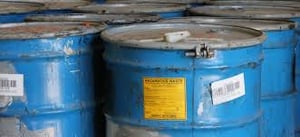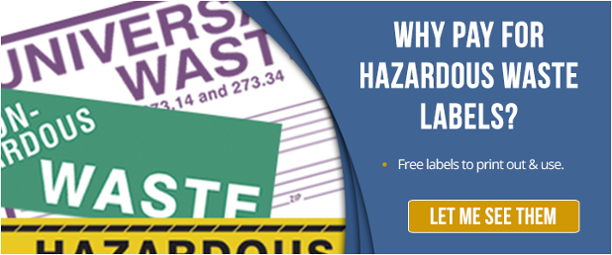If you are a hazardous waste generator who accumulates waste on site in drums, you are responsible for ensuring that all regulations set forth by the Resource Conservation and Recovery Act (RCRA) are followed.
One of the most important components of this federal act is the requirement to properly label drums and other hazardous waste containers. This ensures company employees, hazardous waste transporters and anyone else who may come in contact with your containers’ contents are knowledgeable about the dangers inside.
The California Department of Toxic Substances Control (DTSC), U.S. Department of Transportation (DOT) and the U.S. Environmental Protection Agency (EPA) also have their own sets of hazardous waste drum label requirements.
Because hazardous waste is heavily regulated, ensuring that your company is in compliance with all of the regulatory agencies can be difficult.
Below we’ll outline important requirements for labeling hazardous waste drums, including labeling the contents, where the labels should be placed on the drums and which types of hazardous waste labels to use.
What Should Be Included
Ensuring that your drums' hazardous waste labels are correct and have detailed information is critical to ensuring the safety of  those handling and transporting those drums.
those handling and transporting those drums.
Per state and federal regulations, labels must include the following:
Date Of Accumulation
The date that crews began to accumulate the waste is important, because legally waste can only sit onsite for a certain amount of time. According to the California DTSC, this date must be clearly marked and visible for inspection on each drum.
Important note: Even if a drum has been used by the generator to collect or consolidate waste that was initially accumulated in another container, it is still subject to the same labeling requirements. That means the initial accumulation and “90-day period” dates on the collection drum must be the oldest of the initial accumulation. This may require a date change if older substances are added to the collection drum.
Waste Details
Each container that holds hazardous waste must be labeled with the words “Hazardous Waste.” In addition, each drum must include the composition and physical state of the waste and a statement that calls attention to the particular hazardous properties of the waste.
For shipments of hazardous materials and wastes, the DOT also requires each non-bulk package (maximum capacity no more than 119 gallons) to display the proper shipping name and identification of the hazardous material, as well as the appropriate diamond hazard labels for the primary (and most subsidiary) hazard classes of the hazardous material.
Generator Details
A hazardous waste drum label must also include details about the generator. This includes the name and address of the generator.
The EPA requires the same information for each drum with a capacity of 119 gallons or less, but specifically requires the following verbiage:
HAZARDOUS WASTE - Federal Law Prohibits Improper Disposal. If found, contact the nearest
police or public safety authority or the U.S. Environmental Protection Agency.
Generator’s Name and Address _____________.
Generator’s EPA Identification Number __________________.
Manifest Tracking Number ___________________.
Although the above information collectively includes vital information required on drum labels, our article, Hazardous Waste Label Requirements You Need To Know, outlines specifically what each agency enforces.
Industry Standards
Although the above regulations are imposed by federal and state legislation, there are industry standards that hazardous waste generators are also encouraged to meet when labeling drums.
For example, all personnel should use the same method to label containers. While one company may prefer to use prepared labels, another may prefer handwritten labels. All waste handlers should be properly trained to know what each field on a label requires.
Workers should apply labels to the containers as soon as the waste is placed in the drum. Before reusing drums, all old markings and labels should be washed off or blacked out.
Where Labels Should Go
In addition to a label’s content, there are requirements in regards to where the labels are placed as well.
Here are a few requirements to keep in mind:
- Labels must appear in their entirety. They should not be placed near other labels to avoid being overlooked. Though not required, the DOT recommends a 6-inch space between labels if there is more than one on a drum.
- The primary hazard label should always be given priority in placement. In other words, if the drum includes two labels, the primary label should be placed above and to the left of the subsidiary hazard label.
- Do not place labels on the bottom of drums. This increases the risk of workers overlooking the label.
- Remove any old labels before reusing the drums. This will help avoid confusion over the drum’s contents.
In some cases, you can use a “recurring use label” to revise information such as the initial accumulation date on the labels as needed.
What Kind Of Labels To Use
The actual label itself is not typically regulated. However, what information the label includes is regulated. That’s why it is important to use a hazardous waste label that provides the criteria outlined above.
At minimum, any label you use should at least prompt the following information:
- Generator’s name, address and phone number
- EPA ID number and a manifest tracking number
- EPA waste number and California waste number
- Accumulation start date
- Contents and their composition
- Physical state of the contents
- Hazardous properties, such as whether the contents are flammable, toxic, corrosive or reactive.
- The DOT proper shipping name
There are many sites that offer pre-printed labels, but many of these can be costly and inconvenient, especially when the labels are needed faster than they can be shipped.
However, IDR offers free hazardous waste labels for your storage containers that can be easily downloaded and printed. These labels are compliant with EPA and DOT requirements, offering the assurance you are complying with regulations put into place for a safer workplace.


Comment